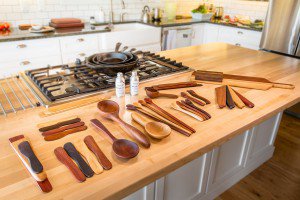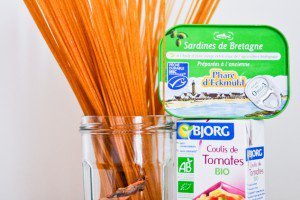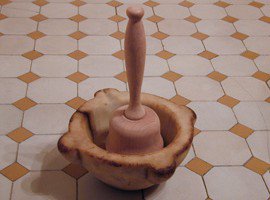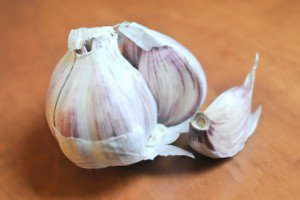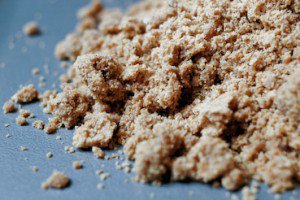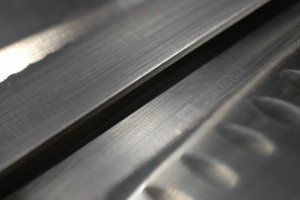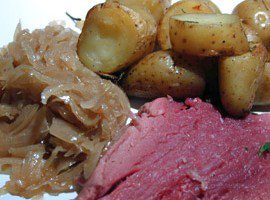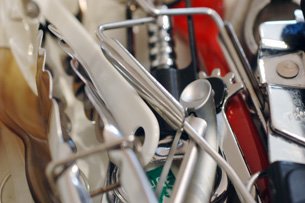
[Part I can be found here.]
Utensils
– A slotted turner, to lift and turn food in the skillet or sauté pan. Choose a heat-resistant one made of silicone or nylon so it won’t scrape your pans.
– A pair of locking tongs, to grab, flip, and arrange food in the pan as precisely as if you were using your fingers, minus the burns.
– Wooden spoons, to stir and mix. It’s nice to have at least two of these. Choose them with a long handle (about 30cm/12”) so your hand will be far from the heat source as you stir.
– A slotted spoon, to lift the solids from a pan and leave the liquids behind. Very handy to serve stews, too.
– A ladle, to transfer and serve soup.
– A heat-resistant silicone spatula, to scrape bowls to the last drop, and smooth out the surface of cake batters.
– A wire whisk.
– A set of measuring cups and spoons. I personally use the same set of cups to measure liquids and solids, and I am still alive.
– A nesting set of mixing bowls. Three is enough; don’t get tricked into buying one of those rainbow-colored sets of ten, however good-looking. Choose plastic or stainless steel; make sure they are stable and don’t tip over too easily. If you’re short on space, get glass or ceramic bowls attractive enough that they can also be used as salad bowls.
– Cutting boards. Wood and plastic are both fine; I myself am partial to bamboo boards. (Note: to avoid cross-contamination, our friends the food safety experts say you should assign three different boards to work with produce, cooked products, and raw animal products.)
– A cooling rack, to speed up the cooling of baked goods so you can eat your cookies sooner.
– A fine-mesh sieve, to strain sauces and marinades. I use mine to sift the flour for cakes.
– A large colander, to drain pasta and set vegetables aside as you chop them.
– A salad spinner to dry your salad greens. It does a good job with fresh herbs, too, no real need to get the miniature one.
– A pepper mill. I love the one Meg gave me, which you operate with one push of the thumb (although, when the reservoir is full, my thumb is not quite strong enough).
– A can opener, preferably one that also has a little metal lip to open jars of jam (and, incidently, bottles of beer).
– A nut cracker. I use a simple yet sturdy vintage one that Maxence’s grandparents gave us.
Not indispensable, but nice to have:
– An oven thermometer, to make sure your oven is not lying to your face. Hang the thermometer inside the oven and rely on it, rather than the thermostat, to know when the temperature is right.
– A lemon juicer. If you don’t have one, stick a fork in the flesh of a halved citrus: hold the fork in one hand, and squeeze the fruit over a small bowl with the other hand. Remove any seeds from the juice with the fork.
– A garlic press, to extract the pulp and juices from a clove of garlic without having to peel it, thus dodging the smell of garlic on your fingers. The garlic press can be an annoying animal to clean, but I use my potato brush with good success.
– A mortar and pestle to make pesto the old-fashioned way (it does make a difference in taste), and grind spice mixes, nuts, or herbs. I have a large marble mortar and a small wooden one, and use either depending on the volume of the stuff I have to grind. (In his Itty Bitty Kitchen Handbook, Justin Spring suggests using a sturdy bowl as the mortar and a flat-bottomed spice jar as the pestle.)
– A rolling pin. If you don’t have one, use a clean, tall, straight-sided bottle, such as a bottle of Bordeaux wine (remove the label).
– A pastry brush to apply egg wash, melted butter, or glaze on baked goods. If you don’t have one, use the back of a small spoon.
– A flexible baking spatula and cutter. This is a thin, narrow, and long-bladed spatula (about 20cm/8”) that my friend Alisa gave to me as a gift, and it is incredibly handy for all manner of things: loosening and lifting baked goods from baking sheets, lifting a loaf of bread from the pot it has baked in, cutting and serving cakes, spreading icing… I’m still looking for things that it won’t do.
– A mini-torch to caramelize sugar on crèmes brûlées or tart crusts, and remove all traces of feathers from a freshly plucked poultry (okay, I’ve never actually done that, but it is what butchers use and they seem pleased with it). You can buy it from a cooking utensils store, or just buy a small regular blowtorch at a hardware store.
– A sugar thermometer, for jams, caramel, and candy.
– A chocolate dipping fork.
– A potato ricer.
– A meat cutting board with a trench that runs all around it, to save the juices.
– A meat fork to keep the roast/poultry in place as you carve it.
– A set of metallic serving circles (mine are 8cm/3” across) to create stacked desserts and vertical platings.
[To be continued.]


